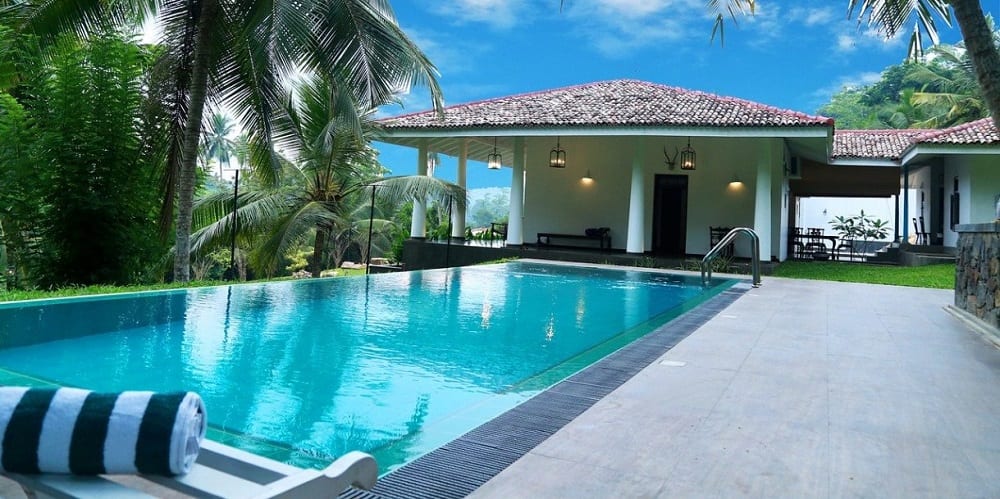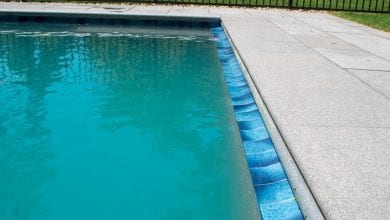
How To Raise Ph Levels In The Pool?
As we’ve said before, it’s up to the pool owner to make sure that their pool chemistry is correct. And that doesn’t mean just chlorine levels either. We’re also talking about other key factors of the pool’s chemistry including total alkalinity, calcium hardness, cyanuric acid levels, and pH levels. All of those are important aspects of the pool’s chemistry to keep track of to ensure that the pool’s water remains clear and healthy.
Although we could devote an entire article to each of the other aspects of your pool’s chemistry, today we’re going to focus on the pH level of your pool. Or, to be more specific, raising the pH level of the pool. So many articles discuss how a high pH level is bad for the pool, so we’re going to talk about how a low pH level is just as bad for the pool’s chemistry profile and ultimately the health of people who use it. And then we’re going to talk about how the pH levels can be raised.
Why Is A Low pH Level Bad?
There are a variety of reasons why a low pH level is undesirable. One of the first things that a low pH level will do is to deteriorate and etch pool surfaces. This includes stone, tile, plaster, and grout. A low pH level will damage those surfaces. It will also cause vinyl surfaces to become more brittle and this, in turn, can make these surfaces tear or crack more easily.
Another thing that a low pH level will do is to make the pool water cloudier. It does this by not allowing clarifying products to bring the particles together so the pool’s filtration system can remove them from the pool. Particles in low pH water just stay suspended in the water, and this leaves it cloudy. Other side effects of a low pH level include:
- Burning Eyes
- Itchy Skin
- Corrosion To Metal Pool Components
- Increased pH Bounce
- Other Pool Chemicals Becoming Ineffective
Why Is A High pH Level Bad?
Before we continue with this guide, we should briefly cover high pH levels, although that isn’t the purpose of this guide. We wanted to highlight the problems caused by high pH levels because we want all of our readers to know that “overcorrecting” their pool’s pH levels can be just as bad as letting them become too low. Pool pH levels always have to be between 7.2 and 7.8. Below are some of the reasons why a high pH level is just as undesirable as a low pH level.
- Can Create Calcium Deposits
- Can Cause Chlorine To Not Work Effectively
- It Can Dry Out Skin
- It Can Sting Eyes
- Can Cause Water Haziness
- Can Lower The Efficiency Of Other Pool Chemicals
What Can Cause Low pH Levels?
Although there are several reasons why a pool might be suffering from pH levels that are too low, one of the primary reasons is a rise in the pool’s carbonic acid levels. When the pool begins to absorb CO2, then carbonic levels will rise and pH levels will fall. Adding too much chlorine will also lower pH levels. Remember, when chlorine is added to water, it forms a weak acid known as Hypochlorous Acid—and adding higher levels of any acid will lower pH levels. Also, a poorly functioning pump and filter can result in consistent low pH levels.
Another fact that many people don’t realize is that a heavy rainstorm can lower pH levels in a pool. That’s because rain has a pH level of anywhere from 5 to 5.5, so it can drag down the pH levels of the pool due to its natural acidity.
Something else that can lower the pH levels of a pool is heavy use. If there’s a bunch of people splashing and swimming in the pool, that can introduce more carbon dioxide into the pool and that can cause an increase in carbonic acid. The higher carbonic acids will then lower pH levels.
Let’s Take A Look At pH Ranges
Okay, let’s see what we’ve covered so far. We’ve covered why low pH levels are bad and why high pH levels are also bad. Before we move on to raising the pH levels of the pool, it’s probably a good idea to give our readers a small pH scale they can use to determine whether they’re pool is in the acceptable range, or if it’s too acidic or prone to scaling. So let’s take a look at some of these numbers before we move on actually correcting pH levels.
- Low pH (Corrosive): 0 To 7.1
- Acceptable: 7.2 to 7.8
- Perfect: 7.4 to 7.6
- High pH (Scaling): 7.9+
It should probably be mentioned that the lower the pH levels, the more acidic the water will become. To show you just how acidic things get when their pH levels drop, we’ve decided to list some of the most common acids and their pH levels. Fortunately, pools are never going to have a pH level of some of these acids, but it is good for comparison.
- Silicic Acid: 6.4
- Boric Acid: 6.12
- Selenic Acid: 2.74
- Sulfuric Acid: 2.75
- Citrus Acid 3.24
How To Raise pH Levels In Your Pool Correctly
Okay, we’ve talked about why low pH levels are bad, so now it’s time for us to pivot toward fixing a low pH problem. And to do that, you’re not only going to need to have the correct information on how to raise pH levels in your pool, but you’re also going to need the right equipment. Below are some of the things that you should have on hand to ensure that your pH levels are balanced correctly.
Items Needed For Balancing pH Levels:
- A Comprehensive Pool Testing Kit
- Soda Ash
- Baking Soda
- Safety Goggles
- Appropriate Clothing
- Rubber Gloves
Step One: Test The Water
The first step you should do before altering the pH levels of your pool in any way is to test it. If the water has a pH level of between 7.2 and 7.8, then you don’t have to do anything to the pool. If the pool has a pH level of over 7.8, then you need to lower the pH level, so this guide won’t help you. However, if the pool has a pH level of under 7.2, then this guide is for you and it’s time to raise the pH levels in your pool.
Step Two: Wear Appropriate Safety Equipment
Regardless of whether you’re lowering or raising the pH levels of your pool, or handling any pool chemicals for that matter, we do recommend wearing the proper equipment. This includes shirts that cover the arms, pants that cover the legs, closed shoes to protect the feet, safety goggles, and rubber gloves. I know that we’ve all seen people adding chemicals to their pool in shorts and sandals, but we encourage everyone reading this to take safety seriously and to wear the proper clothing and safety equipment for the task at hand. As they say, it’s better to be safe than sorry.
Step Three: Read The pH Up Instructions
It doesn’t matter if you’re using pH up, or any other type of chemical in your pool, it’s also advisable to read the instructions on the product. And we don’t mean simply browsing the instructions but reading them and understanding them. This will ensure that you use them properly. We should also mention that if the instructions on your pool chemicals dispute anything we state here in this guide, then the instructions on the chemicals should be the ones that you follow. Don’t worry, it won’t hurt our feelings.
Step Four: Add Soda Ash
Soda ash is an alkaline material that dissolves very well in water and leaves very little trace of itself behind. Adding it to pool water will raise pH levels and lower the acidity of the water. It’s important to be careful using this product as it’s easy to “overcorrect” the pH levels and go from having a low pH level to a high pH level—which will require additional correction.
The first thing that you’re going to want to do is figure out how much soda ash, also known as sodium carbonate, is needed for your pool. You should follow the directions located on the soda ash, but no more than 2-pounds of soda ash per 10,000 gallons of pool water.
It’s also important to make sure that the pool pump is running and is running properly. The soda ash should be distributed evenly across the entire pool’s surface. Allow the pool to run for one hour, and if pH levels are in the normal range, then you’re done. If not, then more soda ash might be necessary.
Step Five: Adjust Pool Alkalinity
If the total alkalinity of the pool needs to be raised, that can be done using sodium bicarbonate, also known as baking soda. Baking soda is often added to the pool after the appropriate amount of soda ash has failed to raise the pH levels of the pool. In this case, the alkalinity of the pool is probably off as that can cause random pH level fluctuations. This is when sodium bicarbonate is needed to fix the problem.
To use baking soda to raise total alkalinity, 1.4-pounds of baking soda per 10,000 gallons of pool water should be added. As was the case with the soda ash, it’s a good idea to allow the pool to circulate at least an hour before testing the water again.
What To Do If Alkalines Don’t Solve pH Problems
Of course, there are cases where pH levels aren’t helped by the addition of soda ash or baking soda. In those instances, it’s probably aeration of the pool’s water that’s causing the problem. Turning on certain water features, or adding aeration pipes can raise the pH levels of the pool. So can pointing jets toward the surface of the pool. However, it should be mentioned that aerating the pool to raise pH levels is going to take several hours, and sometimes a few days, to raise pH levels.
Some Final Bits Of Advice
Before we conclude this guide altogether, we wanted to give our readers a few pieces of advice that will help them maintain a normal pH level in their pool. Although the following bits of information might not be huge revelations to many people, for some of our readers it’s going to be quite useful in helping them keep their pool chemistry in good order. Let’s take a good look at these tips before calling it a day.
Make Sure The Pool Test Kit Isn’t Expired
One of the first tips we’d like to offer is for people to make sure that their test kits aren’t expired. Expired test kits can give faulty readings that don’t let you know what’s really going on with your pool. If your pool testing kit is older than a year old, then it’s probably a good idea to buy a new one.
Always Wear Safety Equipment
Although we’ve already stated this fact several times during this article, it’s worth mentioning it again here. Whenever you use pool chemicals, you should make sure that you wear safety equipment. This includes the appropriate clothing, safety goggles, and gloves. Some of the chemicals used in a pool are extremely dangerous if mishandled, so it’s always a good idea to exercise caution.
Add Chemicals To Water, Never Water To Chemicals
The last point we’d like to make is that powders, particularly acids, are added to water, not the other way around. This is to prevent possibly explosive blow-back. As is always the case when using any pool chemicals, it’s always important for the consumer to read the directions and follow them to the letter.







